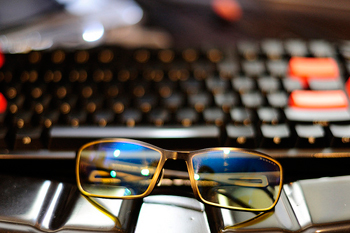8 Vision-Saving Tricks for Computer-Related Eyestrain

With today’s dependence on electronics for work, play, and just about anything to do with productivity, you may often find yourself staring at screens for more than 10 hours a day. With this in mind, it’s important to protect your eyes by minimizing harsh whites and enlarging text size in common programs, regardless of how old you are or how good your eyesight might be.
To lessen the long-term damage computer screens could cause to your eyes, or if your vision isn’t strong enough to read tiny text on your screen, try these tips for PC or Mac computers to make things easier on your oculars. Most of these tricks are simple enough that you won’t have to reinvent (or buy) the wheel. Running Windows 8? These tips apply as well.
1. Attack the problem at its source—drop your monitor brightness. Your screen is the culprit, so why not adjust it to fit your ergonomic needs? Your monitor should come with a how-to guide that will show you how to adjust brightness, contrast, color, and other features, allowing you to tweak these levels and reduce eyestrain. If you can’t find a guide, a brief search on Google for the screen’s manufacturer manual should prove fruitful. If you’re still unable to find any documentation for your monitor or television, all models come with buttons that allow the user to explore menu options that are often hidden. Experiment with these, and you should be able to reduce your monitor’s brightness levels in no time.
2. Invest in a pair of computer readers. Computer readers are glasses that have protective coatings on their lenses designed to lessen the harsh whites that screens can emit. Most readers have a magnifying effect, so you’re practically getting a two-for-one deal. Some companies such as Foster Grant produce readers as cheap as $30. If you’re looking for something a little more high-end and you’re willing to drop the cash, Gunnar Optiks makes a line of sturdy readers that are not only protective but stylish as well. Gunnar’s prescription program lets you combine vision correction with protection. Be wary, however, as the cheaper models can bite holes in your wallet; non-prescription Gunnar models range from $60 to $100.
3. Use the magnifiers. Microsoft is aware that sometimes computer text isn’t the easiest to read. Found with almost all versions of Windows, Magnifier is a versatile program that can enlarge certain parts of the screen wherever your mouse or keyboard cursor is located. If you have a Mac, use the included Zoom software to make reading text a little easier on the eyes.
4. Increase your browser display size. Most screens nowadays come in wide-screen format, and that doesn’t adapt well for documents. Browsers often display websites in a column fashion as well, leaving wide, empty margins. Remove the margins and zoom in on your page by holding down Control and scrolling up with your mouse until the page fits your monitor nicely. On the Mac side, you can increase most browser window sizes by pressing Command and + a few times.
5. Lower the desktop resolution. Your resolution is what makes up your screen in vertical and horizontal “lines.” The more lines the screen has, the smaller images and text will appear. By right-clicking on your desktop in Windows, you can adjust your screen resolution to a lower setting and make those images and text blocks pop. On a Mac, you can find a list of supported resolutions under the Apple logo, System Preferences, and then Display.
6. Increase the Windows text size. Windows 7 has an option to change the text and other items on-screen under the Display option under the Personalize menu, found by right-clicking on the desktop. This option is just limited to three settings: smaller, medium, and larger. Fortunately, an adjustment here should bode well for anyone trying to save their eyesight.
7. Give your eyes a break. Staring at a screen for too long certainly isn’t healthy and can give you computer vision syndrome, or CVS (not the pharmacy). If you find yourself locked onto a screen for too long, look away from the screen, focus on an item in the distance for approximately 10 to 20 seconds, and then focus on an item closer to you. Repeating this a few times should keep your eyes from getting tired.
8. Go outside! Being inside all day not only messes with your sleeping rhythms, it can also have an effect on your eyes. Expose your eyes to different levels of light. This can also kill the monotony of a day’s work at the office!
Whether you have poor or eagle-eyed eyesight, these steps can certainly help you keep the effects of long-term screen exposure at bay. They won’t prevent eyestrain completely, but combining all these steps will significantly save your eyes so you can keep staring at screens for several years to come.
This story originally appeared on Tecca. More from Tecca:
- Future Guide: Tech of tomorrow brings innovation today
- PixelOptics emPower eyeglasses let you switch off your bifocals
- How to relieve eye fatigue caused by your computer screen
[Photo by Mike Saechang]